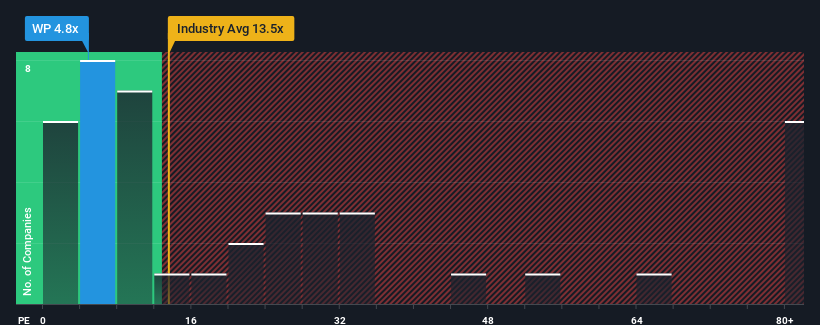- Canada
- /
- Capital Markets
- /
- TSXV:WP
Western Pacific Trust Company (CVE:WP) Doing What It Can To Lift Shares
When close to half the companies in Canada have price-to-earnings ratios (or "P/E's") above 14x, you may consider Western Pacific Trust Company (CVE:WP) as a highly attractive investment with its 4.8x P/E ratio. However, the P/E might be quite low for a reason and it requires further investigation to determine if it's justified.
For example, consider that Western Pacific Trust's financial performance has been poor lately as its earnings have been in decline. It might be that many expect the disappointing earnings performance to continue or accelerate, which has repressed the P/E. However, if this doesn't eventuate then existing shareholders may be feeling optimistic about the future direction of the share price.
See our latest analysis for Western Pacific Trust

Is There Any Growth For Western Pacific Trust?
The only time you'd be truly comfortable seeing a P/E as depressed as Western Pacific Trust's is when the company's growth is on track to lag the market decidedly.
If we review the last year of earnings, dishearteningly the company's profits fell to the tune of 12%. Even so, admirably EPS has lifted 945% in aggregate from three years ago, notwithstanding the last 12 months. Although it's been a bumpy ride, it's still fair to say the earnings growth recently has been more than adequate for the company.
Comparing that to the market, which is only predicted to deliver 22% growth in the next 12 months, the company's momentum is stronger based on recent medium-term annualised earnings results.
In light of this, it's peculiar that Western Pacific Trust's P/E sits below the majority of other companies. It looks like most investors are not convinced the company can maintain its recent growth rates.
What We Can Learn From Western Pacific Trust's P/E?
Using the price-to-earnings ratio alone to determine if you should sell your stock isn't sensible, however it can be a practical guide to the company's future prospects.
We've established that Western Pacific Trust currently trades on a much lower than expected P/E since its recent three-year growth is higher than the wider market forecast. There could be some major unobserved threats to earnings preventing the P/E ratio from matching this positive performance. At least price risks look to be very low if recent medium-term earnings trends continue, but investors seem to think future earnings could see a lot of volatility.
Plus, you should also learn about these 5 warning signs we've spotted with Western Pacific Trust (including 2 which shouldn't be ignored).
Of course, you might also be able to find a better stock than Western Pacific Trust. So you may wish to see this free collection of other companies that have reasonable P/E ratios and have grown earnings strongly.
Valuation is complex, but we're here to simplify it.
Discover if Western Pacific Trust might be undervalued or overvalued with our detailed analysis, featuring fair value estimates, potential risks, dividends, insider trades, and its financial condition.
Access Free AnalysisHave feedback on this article? Concerned about the content? Get in touch with us directly. Alternatively, email editorial-team (at) simplywallst.com.
This article by Simply Wall St is general in nature. We provide commentary based on historical data and analyst forecasts only using an unbiased methodology and our articles are not intended to be financial advice. It does not constitute a recommendation to buy or sell any stock, and does not take account of your objectives, or your financial situation. We aim to bring you long-term focused analysis driven by fundamental data. Note that our analysis may not factor in the latest price-sensitive company announcements or qualitative material. Simply Wall St has no position in any stocks mentioned.
About TSXV:WP
Western Pacific Trust
A non-deposit-taking independent trust company, provides various financial services in Canada.
Excellent balance sheet with moderate risk.
Market Insights
Community Narratives



